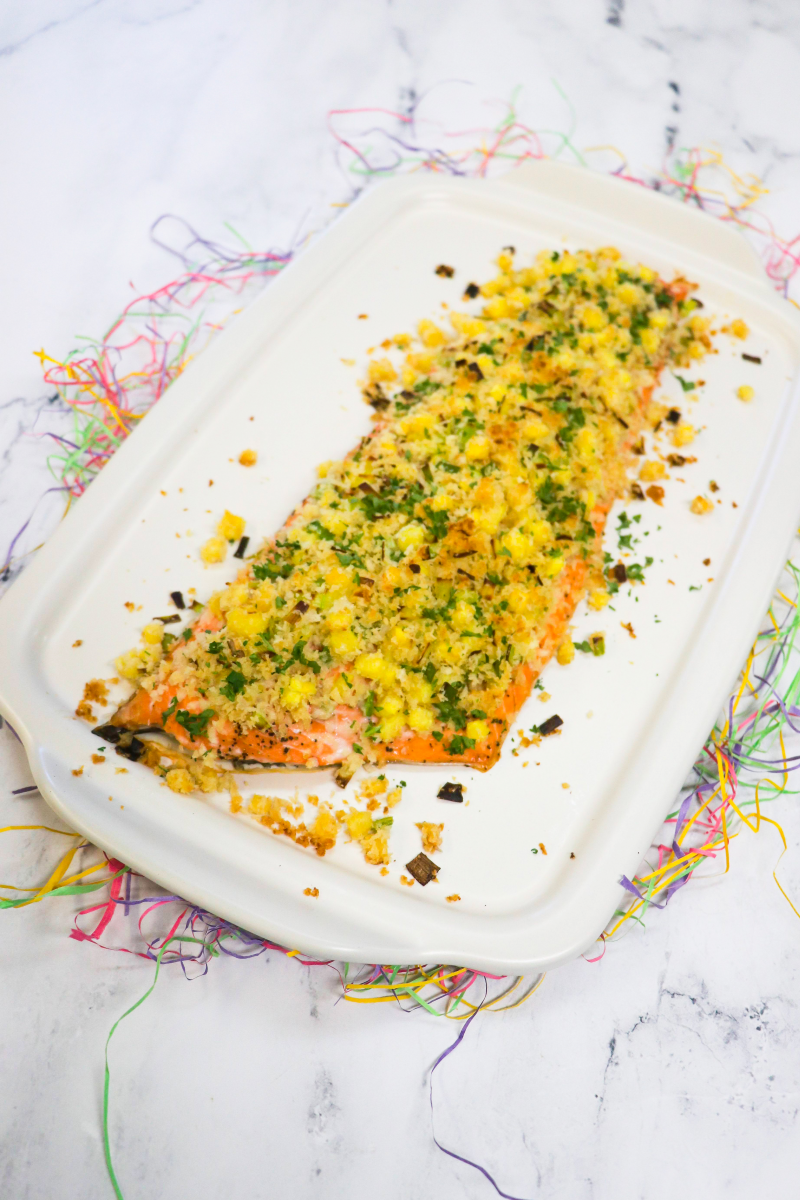Pineapples are not just meant for tropical drinks and housing accommodations for SpongeBob. We found a better way to incorporate this popular fruit with the ocean. The newest creation from Wild For Salmon’s Chef Nicole, Pineapple Leek Crusted Salmon.
The Best Springtime Dish
Second to maybe preparing for Christmas, most of us are eager for that welcomed transition from winter to springtime each and every year. One of the popular ways we do this is in the cuisine we prepare.
In winter we long for hot hearty soups. Summertime is typically the grilling season. Fall of course is filled with pumpkin and apple flavored anything.
Springtime is where we want to break out the bright, bold flavors of freshness. This dish certainly achieves that in both aesthetic and taste! Combining the savory flavor of sockeye salmon with the slight sweetness of pineapple. The bright yellow pineapple combined with the fresh green leeks is almost too beautiful to disrupt. Almost.
What is a Leek?
Leeks are a versatile vegetable that can be found growing in various parts of the world. They are a member of the allium family, which also includes onions and garlic. Leeks are known for their subtle, sweet flavor that can be used in a variety of dishes, from soups and stews to salads and casseroles.
Leeks prefer cool, moist soil and are typically grown in regions with mild climates. They are often grown in the United Kingdom, France, and Belgium, where the climate is ideal for their growth. In the United States, leeks are commonly grown in California and the Pacific Northwest, where the weather is mild and the soil is fertile.
Leeks grow best in soil that is well-draining and rich in organic matter. They require plenty of sunlight and regular watering to thrive. While they can be grown in containers or raised beds, they are most commonly grown in rows in open fields.
In addition to their ideal growing conditions, leeks are also a hardy crop that can withstand cold temperatures and frost. This makes them an excellent choice for fall and winter gardens, as they can be harvested well into the colder months.
Overall, leeks can be grown in a variety of regions around the world, as long as they have access to cool, moist soil, plenty of sunlight, and regular watering.
How to cut Leek
A lot of you are probably familiar with the use of leeks in popular dishes such as potato leek soup. In that application you would be preparing your leek in bigger, longer sections to include in your hearty soup.
For this application we want to dice a leek into small pieces that will mix together with the panko and pineapple.
Since leeks are grown in soil they typically have dirt compacted into the layers, wash or soak your leeks before cutting. Cut off roots before dicing. Dice the leek into small, quarter inch maximum pieces.
How to choose a Pineapple
Like with all fruits, there are many theories on how to choose the right Pineapple from your local store or farmers market. From knocking on the exterior to listening to rolling it on the floor.
Let’s just keep it simple, shall we? You want to look for fresh looking green leaves and a firm shell. The pineapple should have a small amount of “give” to it when gently squeezed.
It should feel heavy, not hollow. Finally, you should be able to get that distinct pineapple smell when you place your nose to the bottom of the fruit.
How to cut a Pineapple
Once you remove the shell of the pineapple, cut the pineapple into rings. From there use a small round cookie cutter to remove the core of each ring.
Cut the rings in half, to quarters, to eighths. From that point, finely dice the pineapple into small pieces.
Keep in mind you want the pieces to be smaller than you would normally eat them so it blends nicely with the panko and leeks.
But really… Pineapple and Salmon?
Yes! This dish may surprise you with its deliciousness! The pineapple, while in other applications can be super sweet, appears ever so subtly in this preparation. Bringing out a great balance of sweet and savory.
The combination of leeks, pineapple, and panko produce a crispy coating to the savory Sockeye that makes each bite a joy.
This recipe is a great segway from the hearty winter dishes to the crisp bold flavors of springtime.

AUTHOR PROFILE
Nicole is the in-house Chef at Wild For Salmon as well as a Recipe Developer and Food Photographer from Allentown, Pennsylvania with an Associate degree from The Culinary Institute of America. Her first memories are of planting seeds with her father and grandfather in their elaborate gardens and sharing their abundant harvests with friends and neighbors. The spark of both pride and joy she felt when sharing this food with others and seeing the happiness it brought them was what inspired her to pursue the culinary arts from a young age. Nicole has spent time exploring the Hudson Valley and Philadelphia food scenes, but her current home in the rolling hills of Central PA is where she most enjoys combining her two passions; exploring the outdoors, and good food.







